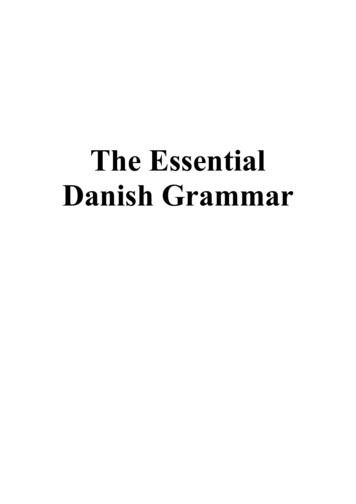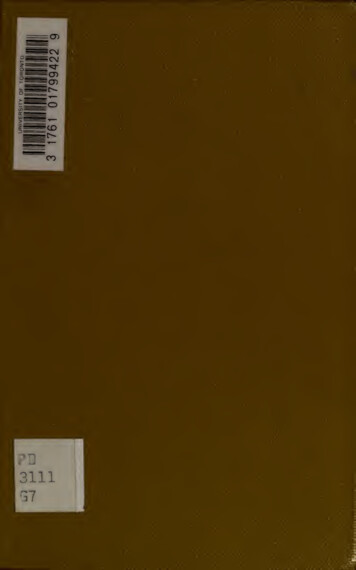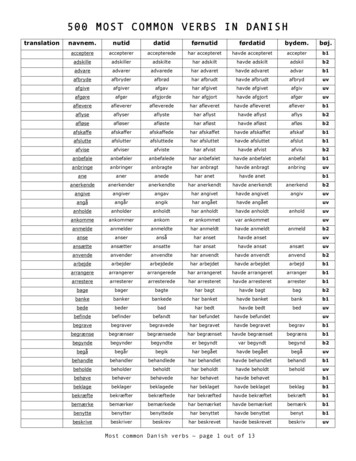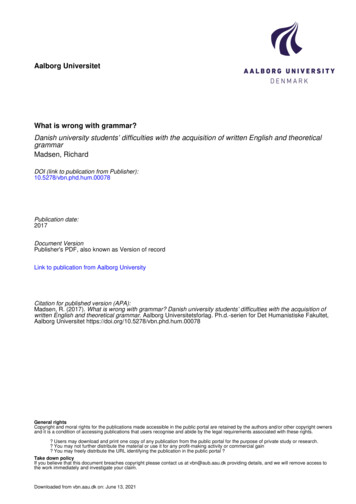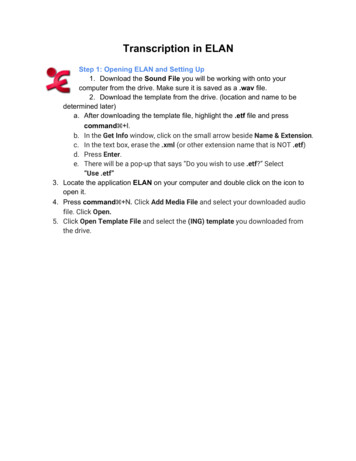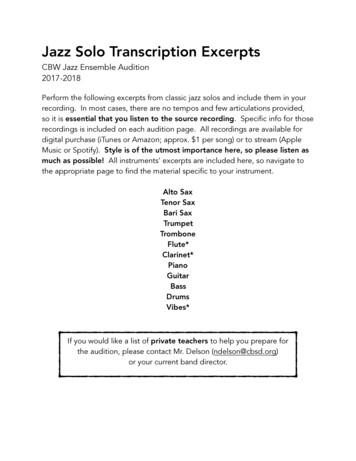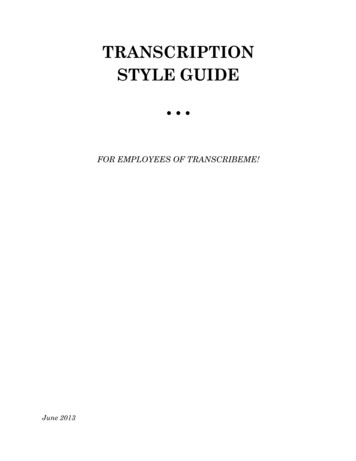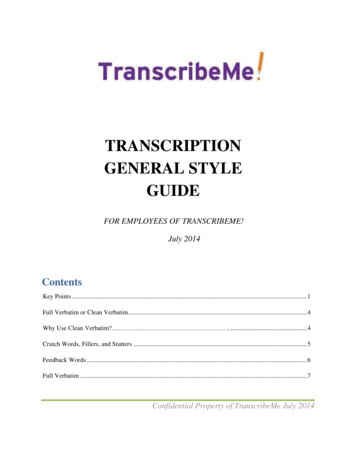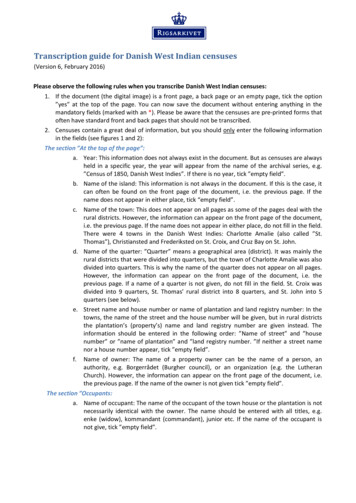
Transcription
Transcription guide for Danish West Indian censuses(Version 6, February 2016)Please observe the following rules when you transcribe Danish West Indian censuses:1. If the document (the digital image) is a front page, a back page or an empty page, tick the option”yes” at the top of the page. You can now save the document without entering anything in themandatory fields (marked with an *). Please be aware that the censuses are pre-printed forms thatoften have standard front and back pages that should not be transcribed.2. Censuses contain a great deal of information, but you should only enter the following informationin the fields (see figures 1 and 2):The section ”At the top of the page”:a. Year: This information does not always exist in the document. But as censuses are alwaysheld in a specific year, the year will appear from the name of the archival series, e.g.”Census of 1850, Danish West Indies”. If there is no year, tick ”empty field”.b. Name of the island: This information is not always in the document. If this is the case, itcan often be found on the front page of the document, i.e. the previous page. If thename does not appear in either place, tick “empty field”.c. Name of the town: This does not appear on all pages as some of the pages deal with therural districts. However, the information can appear on the front page of the document,i.e. the previous page. If the name does not appear in either place, do not fill in the field.There were 4 towns in the Danish West Indies: Charlotte Amalie (also called ”St.Thomas”), Christiansted and Frederiksted on St. Croix, and Cruz Bay on St. John.d. Name of the quarter: ”Quarter” means a geographical area (district). It was mainly therural districts that were divided into quarters, but the town of Charlotte Amalie was alsodivided into quarters. This is why the name of the quarter does not appear on all pages.However, the information can appear on the front page of the document, i.e. theprevious page. If a name of a quarter is not given, do not fill in the field. St. Croix wasdivided into 9 quarters, St. Thomas’ rural district into 8 quarters, and St. John into 5quarters (see below).e. Street name and house number or name of plantation and land registry number: In thetowns, the name of the street and the house number will be given, but in rural districtsthe plantation’s (property’s) name and land registry number are given instead. Theinformation should be entered in the following order: ”Name of street” and ”housenumber” or ”name of plantation” and ”land registry number. ”If neither a street namenor a house number appear, tick ”empty field”.f. Name of owner: The name of a property owner can be the name of a person, anauthority, e.g. Borgerrådet (Burgher council), or an organization (e.g. the LutheranChurch). However, the information can appear on the front page of the document, i.e.the previous page. If the name of the owner is not given tick ”empty field”.The section ”Occupants:a. Name of occupant: The name of the occupant of the town house or the plantation is notnecessarily identical with the owner. The name should be entered with all titles, e.g.enke (widow), kommandant (commandant), junior etc. If the name of the occupant isnot give, tick ”empty field”.
b. When the section ”Occupants” has been completed with information about the firstperson in the document, press ”Add section”, which opens a new section for enteringthe next on the list, and so on.The section ”Other text”:a. Other text on the page: Sometimes there is more information in the margin of the form.This information can be entered into this field. It is not mandatory, but the informationmay be important.b. Your comments: You can enter any comments you may have on what you have typedhere. This also applies if you have background knowledge about the persons or placesthat appear in the document. You should be aware that your comments will be visible toeveryone on the website.3. Personal names should be typed as they appear. This means that spellings should be retainedeven though they may seem to be wrong. The Danish West Indies were multinational andconsequently many names appear in different languages and can be spelled in several differentways.4. Place names should be typed as they appear. If you need help to identify the place name, you canrefer to James William McGuire: Geographic Dictionary of the Virgin Islands of the United States(1925).5. Fields marked with a red asterisk * are mandatory and must be filled in. If you cannot fill in amandatory field, tick ”empty field”.6. All other text in the document that the rules above indicate must be entered as given eventhough the spelling appears to be wrong.7. Abbreviations in the document should be entered as they appear. If you wish to write theabbreviation in full, which you are very welcome to do, please do this in parentheses. Forexample, if a personal name is ”Geo:”, you can write ”Geo: (George)” in the field.8. Dates should be entered as they appear in the document.9. If ’ditto’, ’do’, ’ibid., –II– appear to indicate that a person or a place name is identical with theabove-mentioned, repeat the wording from the entire field being referred to.10. If you cannot read a sentence or a single word in a sentence, type [cannotread].11. You do not have to type the entire document all at once, but we recommend that you do. (See”From the beginning to the complete transcription” at the end of this document). You will only beawarded points for having completed a whole page.Names of quarters in the Danish West Indies: St. Croix, 9 quarters: Compagniets quarter, Dronningens quarter, Kongens quarter, Prinsensquarter, Westende quarter, Ostende quarter A, Ostende quarter B, Nordside quarter A, Nordsidequarter B. St. Thomas rural districts, 8 quarters: Oost Ende quarter, Røde Huck quarter, Frenchman’s Bayquarter, New quarters, Store Nord Side quarter, Lille Nord Side quarter, Syd Side quarter, Vestendequarter. St. Thomas town, 3 quarters: Kongens quarter, Dronningens quarter, Kronprinsens quarter. St. John, 5 quarters: Cruz Bay quarter, Maho Bay quarter, Reef Bay quarter, Coral Bay quarter, OostEnde quarter.2
We would like to hear from you if you wish to comment on this guide. You can either write to us atcrowd@sa.dk (remember to indicate in the subject field which archival collection you are commentingon) or call at 45 41 71 73 00.3
Fig 1: Please type the belowName of occupant: Eleonor HannemannStreet name and house number:Hill Street, 7BName of owner: Frederikka HennemannName of town: ChristianstedName of island: St. Croix4
Fig 2: Please type the belowName of occupant: Theodora KeatingName of quarter: Ny QvarterName of plantation and tax land registry number: Hospitalsgrundene 1BName of island: St. ThomasName of owner: Zephenieh Keating5
Please observe the following rules when you transcribe Danish West Indian censuses: 1. If the document (the digital image) is a front page, a back page or an empty


